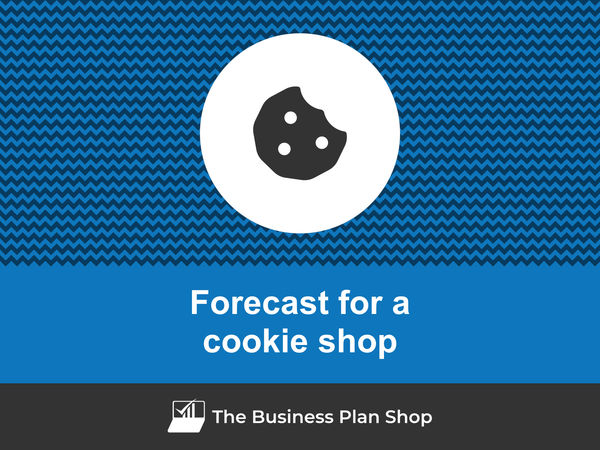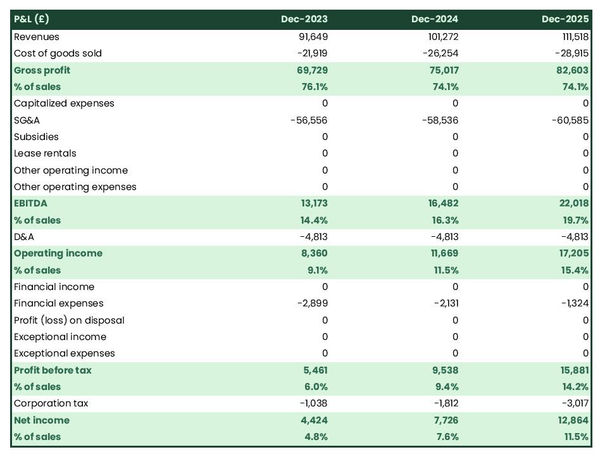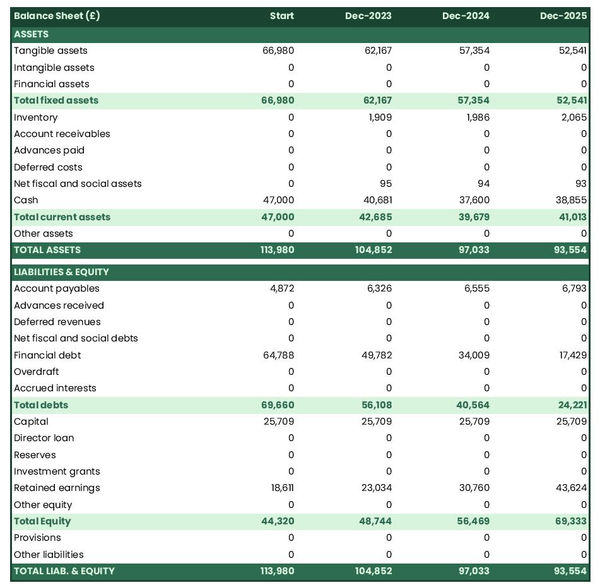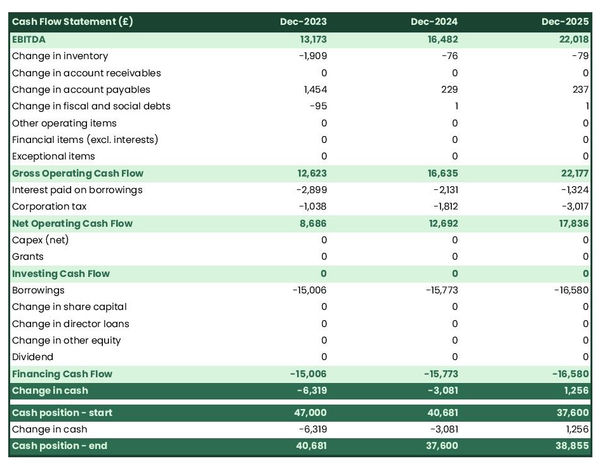How to create a financial forecast for a cookie shop?

Developing and maintaining an up-to-date financial forecast for your cookie shop is key in order to maintain visibility on your business’s future cash flows.
If you feel overwhelmed at the thought of putting together a cookie shop financial forecast then don’t worry as this guide is here to help you.
We'll cover everything from: the main objectives of a financial forecast, the data you need to gather before starting, to the tables that compose it, and the tools that will help you create and maintain your forecast efficiently.
Let's get started!
Why create and maintain a financial forecast for a cookie shop?
Creating and maintaining an up-to-date financial forecast is the only way to steer the development of your cookie shop and ensure that it can be financially viable in the years to come.
A financial plan for a cookie shop enables you to look at your business in detail - from income to operating costs and investments - to evaluate its expected profitability and future cash flows.
This gives you the visibility needed to plan future investments and expansion with confidence.
And, when your trading environment gets tougher, having an up to date cookie shop forecast enables you to detect potential upcoming financing shortfalls in advance, enabling you to make adjustments or secure financing before you run out of cash.
It’s also important to remember that your cookie shop's financial forecast will be essential when looking for financing. You can be 100% certain that banks and investors will ask to see your numbers, so make sure they’re set out accurately and attractively.
Need a solid financial forecast?
The Business Plan Shop does the maths for you. Simply enter your revenues, costs and investments. Click save and our online tool builds a three-way forecast for you instantly.

What information is used as input to build a cookie shop financial forecast?
A cookie shop's financial forecast is only as good as the inputs used to build it.
If you are creating (or updating) the forecast of an existing cookie shop, then you mostly need your accounting information, key historical operating non-financial data, and your team’s input on what to expect for the coming years.
If you are building financial projections for a cookie shop startup, you will need to have done your research and have a clear picture of your competitive environment and go-to-market strategy so that you can forecast sales accurately.
For a new venture, you will also need a precise list of the resources needed to keep the cookie shop running on a day-to-day basis and a list of the equipment and expenditures required to start the business (more on that later).
Let's now take a closer look at the elements that make up your cookie shop's financial forecast.
The sales forecast for a cookie shop
From experience, it usually makes sense to start your cookie shop's financial projection with the revenues forecast.
The inputs used to forecast your sales will include the historical trading data of your cookie shop (which can be used as a starting point for existing businesses) and the data collected in your market research (which both new ventures and existing businesses need to project their sales forward).
Your cookie shop's sales forecast can be broken down into two key estimates:
- The average price
- The number of monthly transactions
To assess these variables accurately, you will need to consider the following factors:
- Seasonal Demand - As a cookie shop owner, you may experience a fluctuation in the number of monthly transactions based on the time of year. For example, during the holiday season, there may be an increase in demand for cookies, resulting in a higher average price and more transactions.
- Competition - The presence of other cookie shops in your area can affect your average price and number of monthly transactions. If there are many competitors offering similar products, you may need to adjust your prices to remain competitive and attract more customers.
- Special Events - Hosting special events such as birthday parties, weddings, or corporate events can greatly impact your sales forecast. These events can generate large orders and increase your average price and number of monthly transactions.
- Ingredients Cost - The cost of ingredients for your cookies can directly affect the average price of your products. If the cost of ingredients increases, you may need to adjust your prices to maintain profitability, which can also impact your number of monthly transactions.
- New Product Launches - Introducing new cookie flavors or products can attract new customers and increase your average price and number of monthly transactions. However, it is important to carefully track the success of these new products to ensure they are positively impacting your sales forecast.
Once you have a sales forecast in place, the next step will be to work on your overhead budget. Let’s have a look at that now.
Need inspiration for your business plan?
The Business Plan Shop has dozens of business plan templates that you can use to get a clear idea of what a complete business plan looks like.

The operating expenses for a cookie shop
The next step is to estimate the costs you’ll have to incur to operate your cookie shop.
These will vary based on where your business is located, and its overall size (level of sales, personnel, etc.).
But your cookie shop's operating expenses should normally include the following items:
- Staff costs: This includes salaries, benefits, and any other expenses related to hiring and retaining employees to help run your cookie shop.
- Rent: You will need to rent a commercial space to operate your cookie shop. This expense may also include utilities and maintenance fees.
- Ingredients: These are the raw materials needed to make your delicious cookies. This expense may vary depending on the type and quantity of cookies you offer.
- Packaging and supplies: You will need to purchase packaging materials, such as boxes and bags, as well as other supplies like baking sheets and mixing bowls.
- Marketing and advertising: To attract customers to your cookie shop, you may need to invest in marketing and advertising efforts, such as flyers, social media ads, and promotions.
- Accountancy fees: Hiring an accountant to help you with bookkeeping, tax preparation, and other financial tasks can be a valuable expense for your cookie shop.
- Insurance costs: Protecting your business with insurance, such as liability insurance and property insurance, is essential in case of any unexpected events.
- Software licenses: You may need to purchase licenses for software programs that help with tasks like inventory management, point of sale systems, and online ordering.
- Banking fees: Your cookie shop will have transaction fees associated with processing credit and debit card payments, as well as fees for maintaining a business bank account.
- Equipment maintenance: Regular maintenance and repairs for equipment, such as ovens and mixers, are necessary to keep your cookie shop running smoothly.
- Professional fees: If you need to hire a lawyer or consultant for legal or business advice, these fees should be included in your operating expenses.
- Licenses and permits: Depending on your location, you may need to obtain specific licenses and permits to operate a food business, such as a food handler's permit or a health department permit.
- Training and development: Investing in your employees' training and development can improve their skills and make your cookie shop more efficient and successful.
- Waste disposal: Properly disposing of food waste and other trash is not only essential for the environment but also a necessary expense for your cookie shop.
- Inventory management: Keeping track of your inventory and ordering supplies in a timely manner can help prevent waste and save money in the long run.
This list is not exhaustive by any means, and will need to be tailored to your cookie shop's specific circumstances.
What investments are needed to start or grow a cookie shop?
Once you have an idea of how much sales you could achieve and what it will cost to run your cookie shop, it is time to look into the equipment required to launch or expand the activity.
For a cookie shop, capital expenditures and initial working capital items could include:
- Commercial Oven: This is an essential purchase for your cookie shop. It allows you to bake large quantities of cookies at once, increasing efficiency and productivity.
- Display Cases: These are necessary for showcasing your delicious cookies to customers. A high-quality and visually appealing display case can attract more customers and increase sales.
- Refrigerator and Freezer: Proper food storage is crucial for maintaining the freshness and quality of your ingredients. A commercial-grade refrigerator and freezer are necessary investments for your cookie shop.
- Point of Sale System: This is the system used to process transactions, manage inventory, and track sales. A modern and efficient point of sale system can save you time and improve the overall operations of your cookie shop.
- Furniture and Decor: Creating a cozy and welcoming atmosphere in your cookie shop can enhance the customer experience. Consider investing in comfortable seating, tables, and decorative elements to make your space more inviting.
Again, this list will need to be adjusted according to the specificities of your cookie shop.
Need a convincing business plan?
The Business Plan Shop makes it easy to create a financial forecast to assess the potential profitability of your projects, and write a business plan that’ll wow investors.

The financing plan of your cookie shop
The next step in the creation of your financial forecast for your cookie shop is to think about how you might finance your business.
You will have to assess how much capital will come from shareholders (equity) and how much can be secured through banks.
Bank loans will have to be modelled so that you can separate the interest expenses from the repayments of principal, and include all this data in your forecast.
Issuing share capital and obtaining a bank loan are two of the most common ways that entrepreneurs finance their businesses.
What tables compose the financial plan for a cookie shop?
Now let's have a look at the main output tables of your cookie shop's financial forecast.
The forecasted profit & loss statement
The profit & loss forecast gives you a clear picture of your business’ expected growth over the first three to five years, and whether it’s likely to be profitable or not.

A healthy cookie shop's P&L statement should show:
- Sales growing at (minimum) or above (better) inflation
- Stable (minimum) or expanding (better) profit margins
- A healthy level of net profitability
This will of course depend on the stage of your business: numbers for an established cookie shop will look different than for a startup.
The projected balance sheet
Your cookie shop's forecasted balance sheet enables you to assess your financial structure and working capital requirements.
It is composed of three types of elements: assets, liabilities and equity:
- Assets: represent what the business owns and uses to produce cash flows. It includes resources such as cash, equipment, and accounts receivable (money owed by clients).
- Liabilities: represent funds advanced to the business by lenders and other creditors. It includes items such as accounts payable (money owed to suppliers), taxes due and loans.
- Equity: is the combination of what has been invested by the business owners and the cumulative profits and losses generated by the business to date (which are called retained earnings). Equity is a proxy for the value of the owner's stake in the business.

The cash flow projection
The cash flow forecast of your cookie shop will show how much cash the business is expected to generate or consume over the next three to five years.

There are multiple ways of presenting a cash flow forecast but from experience, it is better to organise it by nature in order to clearly show these elements:
- Operating cash flow: how much cash is generated by the cookie shop's operations
- Investing cash flow: what is the business investing to expand or maintain its equipment
- Financing cash flow: is the business raising additional funds or repaying financiers (debt repayment, dividends)
Your cash flow forecast is the most important element of your overall financial projection and that’s where you should focus your attention to ensure that your cookie shop is adequately funded.
Note: if you are preparing a financial forecast in order to try to secure funding, you will need to include both a yearly and monthly cash flow forecast in your cookie shop's financial plan.
Need a solid financial forecast?
The Business Plan Shop does the maths for you. Simply enter your revenues, costs and investments. Click save and our online tool builds a three-way forecast for you instantly.

Which tool should you use to create your cookie shop's financial forecast?
Creating your cookie shop's financial forecast may sound fairly daunting, but the good news is that there are several ways to go about it.
Using online financial forecasting software to build your cookie shop's projections
The modern and easiest way is to use professional online financial forecasting software such as the one we offer at The Business Plan Shop.
There are several advantages to using specialised software:
- You can easily create your financial forecast by letting the software take care of the financial calculations for you without errors
- You have access to complete financial forecast templates
- You get a complete financial forecast ready to be sent to your bank or investors
- You can easily track your actual financial performance against your financial forecast, and recalibrate your forecast as the year goes by
- You can create scenarios to stress test your forecast's main assumptions
- You can easily update your forecast as time goes by to maintain visibility on future cash flows
- You have a friendly support team on standby to assist you when you are stuck
- It’s cost-efficient and much cheaper than using an accountant or consultant (see below)
If you are interested in this type of solution, you can try our forecasting software for free by signing up here.
Hiring a financial consultant or chartered accountant
Hiring a consultant or chartered accountant is also an efficient way to get a professional cookie shop financial projection.
As you can imagine, this solution is much more expensive than using software. From experience, the creation of a simple financial forecast over three years (including a balance sheet, income statement, and cash flow statement) is likely to start around £700 or $1,000 excluding taxes.
The indicative estimate above, is for a small business, and a forecast done as a one-off. Using a financial consultant or accountant to track your actuals vs. forecast and to keep your financial forecast up to date on a monthly or quarterly basis will naturally cost a lot more.
If you choose this solution, make sure your service provider has first-hand experience in your industry, so that they may challenge your assumptions and offer insights (as opposed to just taking your figures at face value to create the forecast’s financial statements).
Why not use a spreadsheet such as Excel or Google Sheets to build your cookie shop's financial forecast?
Creating an accurate and error-free cookie shop financial forecast on Excel (or any spreadsheet) is very technical and requires both a strong grasp of accounting principles and solid skills in financial modelling.
Most entrepreneurs lack the expertise required to create an accurate financial forecast using spreadsheet software like Excel or Google Sheets. As a result, it is unlikely anyone will trust your numbers.
The second reason is that it is inefficient. Building forecasts on spreadsheets was the only option in the 1990s and early 2000s, nowadays technology has advanced and software can do it much faster and much more accurately.
This is why professional forecasters all use software. With the rise of AI, software is also becoming smarter at helping us detect mistakes in our forecasts and helping us analyse the numbers to make better decisions.
Finally, like everything with spreadsheets, tracking actuals vs. forecasts and updating your forecast as the year progresses is manual, tedious, error-prone, and time-consuming. Whereas financial forecasting software like The Business Plan Shop is built for this.
Need a convincing business plan?
The Business Plan Shop makes it easy to create a financial forecast to assess the potential profitability of your projects, and write a business plan that’ll wow investors.

Use our financial projection templates for inspiration
The Business Plan Shop has dozens of financial forecast templates available.
Our examples contain a complete business plan with a financial forecast and a written presentation of the company, the team, the strategy, and the medium-term objectives.
Whether you are just starting out or already have your own cookie shop, looking at our financial forecast template is a good way to:
- Understand what a complete business plan should look like
- Understand how you should model financial items for your cookie shop

Takeaways
- A financial forecast shows expected growth, profitability, and cash generation metrics for your cookie shop.
- Tracking actuals vs. forecast and having an up-to-date financial forecast is key to maintaining visibility on your future cash flows.
- Using financial forecasting software is the modern way of creating and maintaining financial projections.
We hope that this guide helped you gain a clearer perspective on the steps needed to create the financial forecast for a cookie shop. Don't hesitate to contact us if you have any questions!
Need inspiration for your business plan?
The Business Plan Shop has dozens of business plan templates that you can use to get a clear idea of what a complete business plan looks like.

Also on The Business Plan Shop
Know someone who runs a cookie shop? Share our business guide with them!




